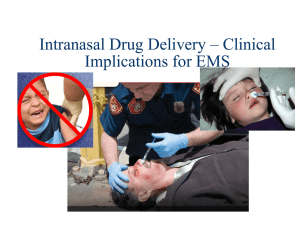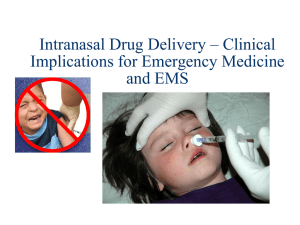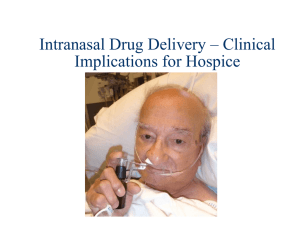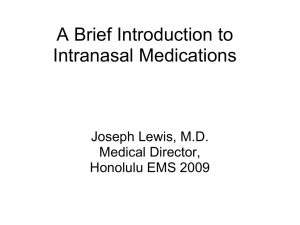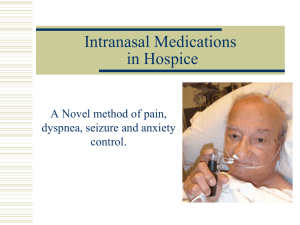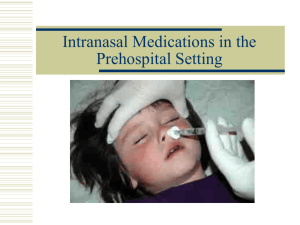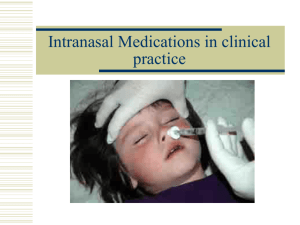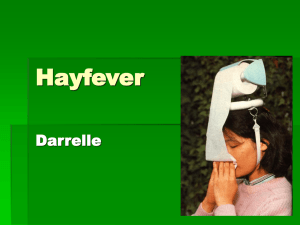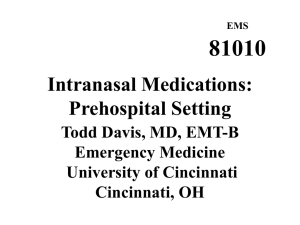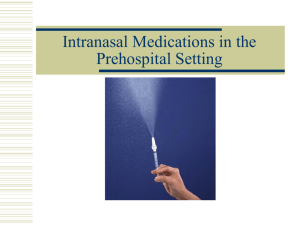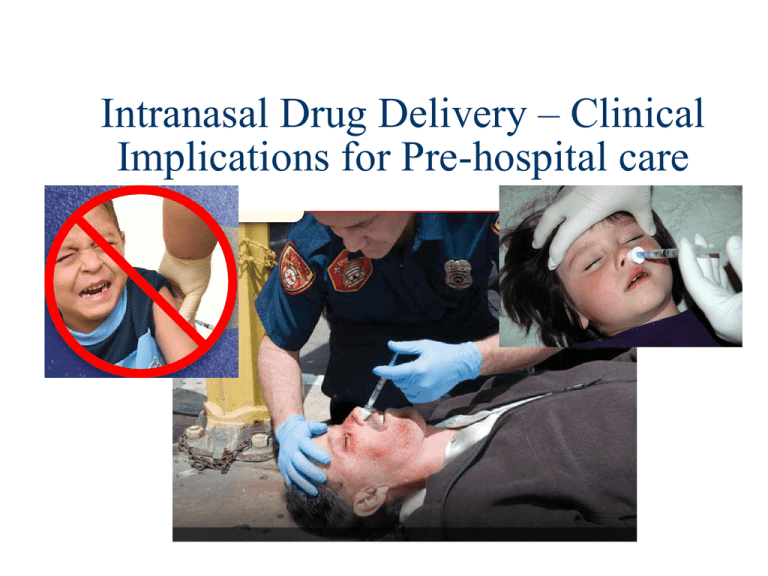
Intranasal Drug Delivery – Clinical
Implications for Pre-hospital care
Lecture outline
Why use intranasal medications?
Intranasal drug delivery: General concepts
Intranasal drugs indications with clinical cases
and personal insights:
• Pain Control
• Sedation
• Seizures
• Opiate overdose
Drug doses
Resources
Why do I think nasal drug delivery is
important in prehospital care?
Efficacy, speed and ease of delivery
No delivery delays (no IV)
Can deliver to anyone with an exposed nose
Rapid onset of action (Pain control, Sedation, seizure, overdose)
As effective and fast as IV drugs in most situations
Safety
No needle stick risk
Lower risk of respiratory depression (compared to IV)
Easier to proceed with additional care
Start IV in children or agitated adult
Calm the agitated patient
Understanding IN delivery:
General principles
First pass metabolism
Nose brain pathway
Bioavailability / Drug absorption
Safety vs IV drugs
First pass metabolism
Nasal Mucosa:
No first pass
metabolism
Gut
mucosa:
Subject to
first pass
metabolism
Nose brain pathway
The olfactory mucosa
(smelling area in nose) is in
direct contact with the brain
and CSF.
Medications absorbed across
the olfactory mucosa directly
enter the CSF.
Offers a rapid, direct route for
drug delivery to the brain
(skipping the blood brain
barrier).
Olfactory mucosa, nerve
Brain
CSF
Highly vascular nasal mucosa
Nose brain pathway
Bioavailability/ Drug absorption
How much of the administered medication actually
ends up in the blood stream.
Examples:
IV medications are 100% bioavailable.
Most oral medications are about 5%-10% bioavailable
due to destruction in the gut and liver.
Nasal medications vary depending on molecule, pH, etc
Midazolam 75+%
Fentanyl and Sufentanil 80+%
Naloxone 90+%
Lorazepam, ketamine, Romazicon, etc
Optimizing Bioavailability of IN
drugs
Critical
Minimize volume - Maximize concentrationConcept
0.2 to 0.3 ml per nostril ideal, 1 ml is maximum
Most potent (highly concentrated) drug should be used
Maximize total absorptive mucosal surface area
Use BOTH nostrils (doubles your absorptive surface area)
Use a delivery system that maximizes mucosal
coverage and minimizes run-off.
Atomized particles across broad surface area
Beware of abnormal nasal mucosal characteristics
Mucous, blood and vasoconstrictors may reduce absorption
Suction nose or consider alternate delivery route if present
Dropper vs Atomizer
Absorption
Drops = runs down to
pharynx and swallowed
Atomizer = sticks to broad
mucosal surface and absorbs
Usability / acceptance
Drops = Minutes to give,
cooperative patient, head
position required
Atomizer = seconds to
deliver, better accepted
Dropper vs Atomizer
Merkus 2006
Safety of Nasal drugs
Safety and onset of Nasal drugs
Intranasal Medications
What IN medications can we use in
Prehospital care?
Nasal Drug Delivery:
What Medications?
Pain control – Opiates, other
Fentanyl, ketamine?
Sedation- Benzodiazepines
Midazolam, lorazepam
Seizure Therapy – Benzodiazepines
Midazolam, lorazepam
Opiate overdose - Naloxone
Intranasal Medication Cases
Pain Control
Case: MVC
pinned in car
A 35 year old male pinned in a car following an MVC.
Bilateral upper arm fractures, femur fracture, likely
other injuries. Screaming in pain.
Clinical Needs: Pain control, sedation, rapid
extraction, then IV access (cannot do so now).
Treatment: 1.5 mcg/kg of intranasal fentanyl plus 5
mg IN midazolam
In 7 minutes his pain is much better controlled and he is
calmer
Extraction requires 20 minutes, then full trauma
assessment and care proceeds.
Case: Pediatric
Hand burn
A 5 year old burned her hand on the stove
Clinical Needs: Pain control, Transport for wound
care
Treatment: 2.0 mcg/kg of intranasal fentanyl (40
mcg – 0.8 ml of generic “IV” fentanyl)
Within 3-5 minutes her pain is improved
She is transported to a nearby medical facility
15 minutes later the patient easily tolerates cleansing of
the burn and dressing application.
Literature to support these cases - pediatrics
Nasal
Intravenous
Borland, Ann Emerg Med 2007
Pain control –
Literature support
Over a decade of prehospital and ER literature exists for
burn, orthopedic trauma and visceral pain in both adults
and children showing the following:
Faster drug delivery (no IV start needed) so faster onset
Equivalent to IV morphine
Superior to IM morphine
Care givers are more likely to treat pediatric severe pain
Highly satisfied patients and providers
Safe
Pain control –
Literature support
Prehospital and wounded soldier literature
Rickard 07 (MAD): IN fentanyl equal to IV morphine for pain
control in adults. No IV needed.
McLean 09 (MAD): IN fentanyl very effective for adult ski
trauma victims with onset of action on less than 5 minutes
Johnstone 09 (MAD): IN fentanyl in ambulance is very effective
for “visceral” non-traumatic pain in adults.
U.S. Military: Ketamine 50 mg IN is as good/better than
morphine 7.5 mg IV for acute pain and the soldier can self
administer and potentially continue his mission.
Intranasal Ketamine for pain ?:
Literature support
US Army IN
ketamine data
Compared IN
ketamine to IV
morphine for
severe pain
IN ketamine (50
mg) as fast and as
good as IV
morphine (7.5 mg)
w/o side effects.
The Doubters: Surely IN drugs
can’t be as good as an injection
for pain control!
Nasal
Intravenous
ACTUALLY – They are equivalent or better (in these settings)
Borland 2007 – IN fentanyl onset of action and quality of pain control
was identical to IV morphine in patients with broken legs and arms
Borland 2008, Holdgate 2010, Crellin 2010 - time to delivery of IN
opiates was half that of IV and more patients get treated
Kendal 2001 – IN opiate superior to IM opiate for pain control
Conclusions
IN opiates are just as good as IV
IN opiates are delivered in half the waiting time as IV
IN opiate are preferred by patients, providers and parents over
injections
IN opiates for Pain control – My
insights
• I use nasal opiates in my practice - daily.
• Our statewide ambulance services –IN fentanyl is the first line
pain treatment in all children, adult option. ?Nasal ketamine soon?
• Generic concentrations available in U.S. work fine and are
inexpensive ($1-4/vial)
• Efficacy: Very effective – and it can be titrated.
• Segway to IV therapy in the appropriate situation (fear, agitation)
Intranasal Medication Cases
Sedation
Case: Excited Delirium
A 27-year old male is apprehended by police and
paramedics for extremely violent, out of control
behavior following use of crystal meth.
He is at significant risk of injuring himself and others.
It is too dangerous (needle stick risk) to give him an
injection of sedatives.
The paramedic administers 10 mg of IN midazolam and
7 minutes later he is calm and can be transported safely
to the hospital.
Sedation –
Literature support
Hundreds of articles dating back into the 1980’s. Most
used midazolam.
Effective only if adequate dose is given (0.4 to 0.5 mg/kg in
kids, 10 mg straight dose in adults)
Effective in children and adults (even exited delirium in EMS)
Safe – no reports of respiratory depression
IN Benzos for sedation – my insights
The EMS literature is just emerging: Many cases reported,
few good actual studies
Timing: Sedation onset with midazolam at about 5-10
minutes, maximal at 10-20 and starts to wear off at 25-30.
Efficacy: Sedation is not deep but it takes the edge off and
can make further care less stressful or dangerous
Lorazepam?: More data needs to be obtained for
lorazepam. My experience – lasts longer, 75% effective.
Ketamine?: Mixed results, doses of at least 5 mg/kg
needed, more data needs to be obtained in prehospital and
ER environment before conclusions can be made.
Intranasal Medication Cases
Seizure Control
Case: Seizing child
The ambulance is transporting a 13 y.o. girl suffering a grand
mal seizure.
Despite trying, no IV can be successfully established.
Rectal diazepam is unsuccessful at controlling the seizure.
IV attempts in the clinic / hospital are also unsuccessful.
However, on patient arrival a dose of nasal midazolam
(Versed, Dormicum) is given and within 3 minutes of drug
delivery the child stops seizing.
Seizure Therapy Literature support
Lahat 2000; Fisgin 2002; Holsti 2006; Ahmad 2006; Arya 2011;
Holsti 2011; Javadzadeh 2012; Thakker 2012:
IN midazolam is superior to rectal diazepam for seizure control and
is preferred by care givers
IN midazolam is superior to intramuscular injection of paraldehyde
IN midazolam/lorazepam is equivalent to intravenous delivery for
stopping seizures, much faster at stopping them due to no IV start
needed and it leads to less respiratory depression and less need for
airway management that either IV or rectal drugs
IN midazolam can be delivered by family at home safely and
effectively
Onset of nasal vs buccal seizure drugs
(Time of onset matters)
Anderson 2011: IN vs buccal lorazepam
Seizure Therapy - expenses
Cost: Average wholesale price
Rectal diazepam
(Diastat brand name)
10 mg: $120/dose
IN midazolam
10 mg: $3.20
The Doubters: Surely IN drugs
can’t be as good as IV for seizures!
ACTUALLY – They are equivalent or better (in these settings)
Lahat 00, Mahmoudian 04, Arya 11, Thakker 12, Javadzadeh
12 – IV and IN are equivalent for stopping seizures rapidly,
but IN works faster due to no delays
Holsti 2007, Fisgin 2002 – IN is superior to rectal
Holsti 2011 – IN is safe at home with immediate results
Conclusions
IN seizure medication are just as good as IV, better than rectal
IN seizure medication are delivered much more rapidly so seizure stops
sooner.
Anyone (Parents, care givers, nursing home staff, ambulance driver,
etc.) can administer the medication so seizure length is shorter.
IN benzodiazepines for
seizures – My insights
Very effective, very fast: Rapid seizure resolution
without IV access.
Should be first line therapy in ALL prolonged acute
seizures while IV access is being established (if at all)
Effective and safe at home, in prehospital setting, in
hospital
More effective, less expensive and preferred by
providers when compared to alternative (rectal
diazepam).
Intranasal Medication Cases
Opiate Overdose
Case: Heroin
Overdose
The ambulance responds to an unconscious, barely breathing
patient with obvious intravenous drug needle marks on both
arms – consistent with heroin overdose
After an IV is established, naloxone (Narcan) is
administered and the patient is successfully resuscitated.
Unfortunately, the medic suffers a contaminated needle stick
while establishing the IV.
The patient admits to being infected with both HIV and
hepatitis C. He remains alert for 2 hours with no further
therapy in the ED (i.e.- no need for an IV) and is discharged.
Case: Heroin Overdose
The medic now needs treatment - HIV prophylaxis
The next few months will be difficult for him:
Side effects that accompany HIV medications
Personal life is in turmoil due to issues of safe sex with
his spouse
Mental anguish of waiting to see if he develops HIV or
hepatitis C.
He wonders why his system is not using MAD nasal
to deliver naloxone on all these patients.
Case: Methadone
induced coma
A mother enters her daughters room to find her unconscious,
barely breathing, blue color. Since her daughter is on
methadone maintenance, the family was trained to deliver
rescue naloxone (see photo of kit above).
The mother quickly delivers the naloxone intranasally.
She provides 2-3 minutes of rescue breathing until her
daughter begins to arouse. She gradually awakens over 10
minutes.
The patient is transferred to the emergency room for
observation due to the long half life of naloxone, but makes an
uneventful recovery.
Opiate overdose –
Literature support
Intranasal naloxone literature
Barton 02, 05; Kelly 05; Robertson 09; Kerr 09; Merlin 2010;
Doe Simkins 09; Walley 12:
IN naloxone is at least 80-90% effective at reversing opiate
overdose
When compared directly it is equivalent in time of onset and in
efficacy to IV or IM therapy.
IN naloxone results in less agitation upon arousal
IN naloxone is lay person approved in many places. It is safe, has
saved many lives and reduces medical resource consumption
IN naloxone for opiate overdose
– my insights
Why not? Is there a downside?
High risk population for HIV, HCV, HBV
Difficult IV to establish due to scarring of veins
Elimination of needle eliminates needle stick risk
They awaken more gently than with IV naloxone
New epidemiology shows prescription drugs (methadone, etc)
are causing many deaths that naloxone at home could reverse.
Simple enough that lay public can administer and not even call
ambulance
Every ambulance system, police agency and many clinics and
families with high risk patients should be utilizing this
approach.
Drug doses
Scenario
Drug and Dose
Important Reminders
Pain Control
Fentanyl: 2 mcg/kg
? Ketamine 1 mg/kg
•Titration is possible
•Half up each nostril
Sedation
Midazolam: 0.5 mg/kg
•Use concentrated formula
Seizures
Midazolam: 0.2 mg/kg
Lorazepam 0.1 mg/kg
•Support breathing while waiting
•Use concentrated formula
Opiate Overdose Naloxone: 2 mg
•Support breathing while waiting
Intranasal medications summary
Another tool for drug delivery to
supplement standard IV, IM, PO–very
useful when appropriate
Supported by extensive literature
Inexpensive
Speeds up care in many situations
Safe
Questions?
Educational Web site:
www.intranasal.net

